17 June 2024
![]() 8 mins Read
8 mins Read
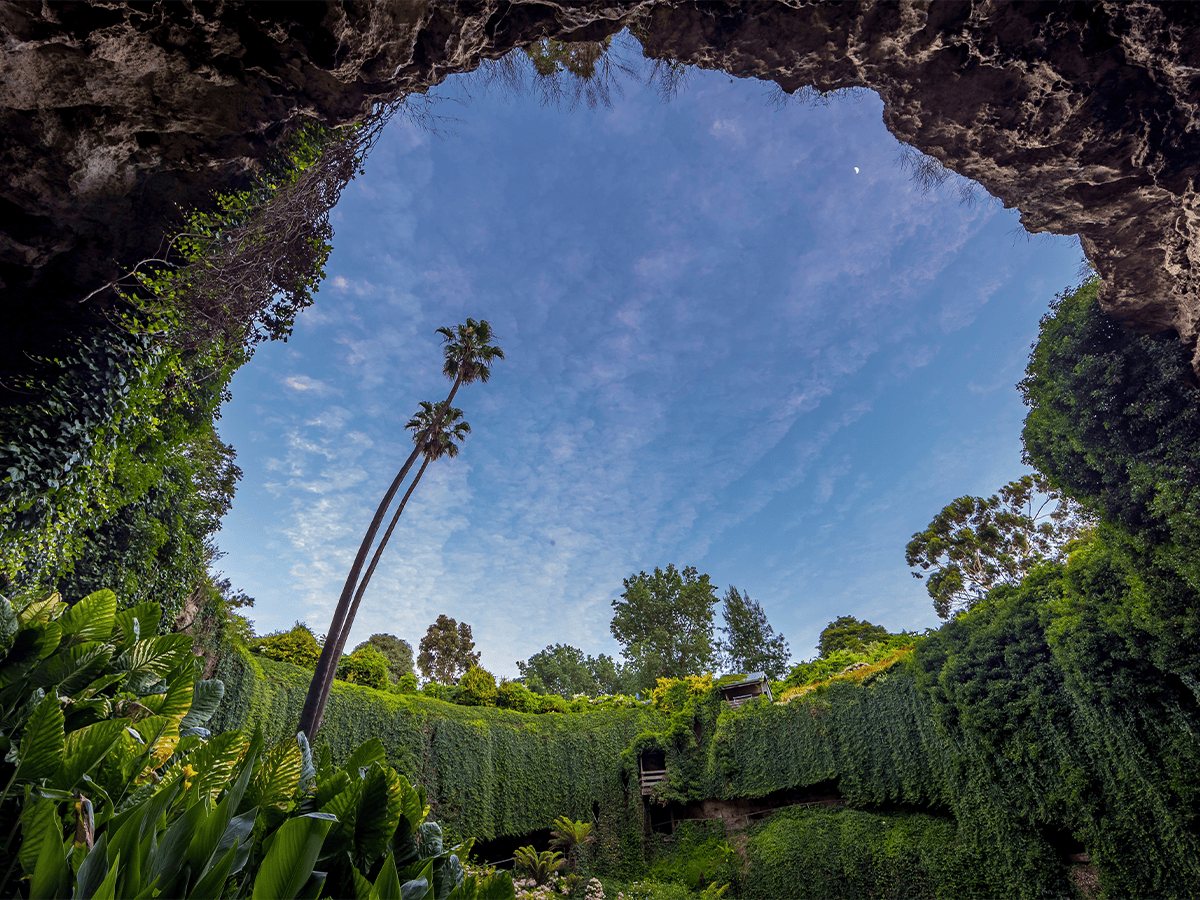
Despite being the second-most populous city in South Australia, this Limestone Coast destination tends to slip under the radar – a great shame given the natural wonders and cultural attractions it has to offer, many of which are free to visit. Here are some of the top things to do in Mount Gambier.
Prepare to be floored by Mount Gambier’s Blue Lake. This sizable body of water, situated within a dormant volcanic crater, transforms from an otherwise pedestrian navy blue into a startling milky turquoise between November and March.
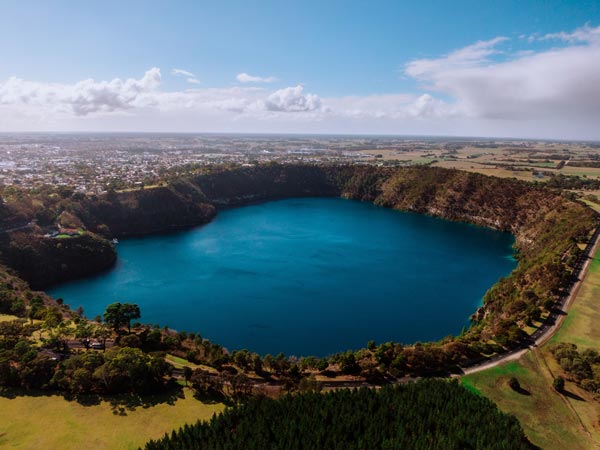
Visit Mount Gambier’s Blue Lake between November and March to see its transformation. (Image: Jaxon Foale/South Australia Tourism Commission)
While you can’t swim in it, you can walk (or drive) around the lake’s rim, which measures some 3.6 kilometres, taking around 45 minutes to complete on foot. Or visit with Aquifer Tours, which takes visitors in a glass-panelled lift down the original dolomite well shaft, through a tunnel to see the Blue Lake in close proximity. You’ll also hear yarns about local folklore and Aboriginal legend, as well as the lake’s history and European settlement.
A volcanic sinkhole located in the middle of a paddock, about a 17-kilometre drive south of Mount Gambier, off an otherwise nondescript country road, Little Blue Lake has that wonderful air of chancing upon a secret local spot.
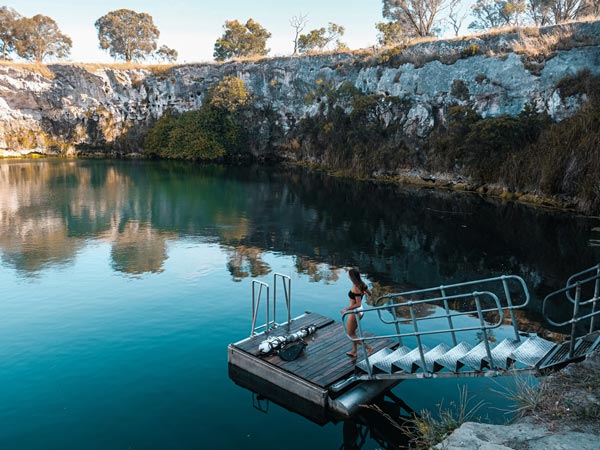
The Little Blue Lake is a volcanic sinkhole located in the middle of a paddock. (Image: Lucy Adamopoulos/South Australia Tourism Commission)
Walk down the stairs, cut into the side of the sinkhole’s cliff, and jump off the floating pontoon into the cool waters, which reach a depth of around 47 metres. Cave divers with a CDAA Deep Cavern grade certification can even dive here.

Jump off the floating pontoon in Little Blue Lake. (Image: Lucy Adamopoulos)
Positively dripping with greenery, this vast sunken garden is arguably Mount Gambier’s landmark attraction. Lying just on the edge of town, this sinkhole was first transformed into a garden in 1886, when local farmer and politician James Umpherston took it upon himself to plant a garden in the former cave.

Umpherston Sinkhole is arguably Mount Gambier’s landmark attraction. (Image: South Australian Tourism Commission/Adam Bruzzone)
Whether you’re looking down into it or taking a wide-angle picture from the floor of the 20-metre-deep, 50-metre-wide natural wonder, the views are something special. Follow the public park’s walking paths, admire the lush foliage from its viewing platforms and benches, and mosey past its sculptures and fountains. It’s the perfect place for a picnic. Umpherston Sinkhole is also home to a colony of common brushtail possums, which make an appearance every evening at dusk to feed.
Much like its Mount Gambier cousin, the Umpherston Sinkhole, Cave Garden is an impossibly scenic spot, alive with greenery and tucked away right in the heart of the city.
A much smaller wedge of a sinkhole, you can’t descend to the base of Cave Garden: instead, exploit the viewing platforms and peer down into the chasm. And if you visit during, or shortly after wet weather, you can even admire a waterfall pouring into it. It’s believed that this sinkhole was in fact the original water source for early settlers in the area.
Refusing to be beaten on nighttime draws by the Umpherston Sinkhole, Cave Garden also has its own after-dark attraction – a nightly light show that tells Aboriginal Dreamtime stories.

The Cave Gardens illuminated as part of a winter light festival. (Image: South Australian Tourism Commission)
It’s estimated that there are a whopping 800 caves littered throughout the Limestone Coast region like honeycomb. Here are some of the must-sees.
Experienced divers come from all over to take to the waters of Engelbrecht Cave, in the centre of Mount Gambier, with its secret, water-filled tunnels. But you don’t need to brandish a certificate just to gain entry to the cave: guided tours of two of Engelbrecht’s caverns are available, lasting around 40 minutes long. There’s also a cafe at the site if you’d like to sit and enjoy cake and coffee after your visit.

Engelbrecht Cave is a geological wonderland. (Image: City of Mount Gambier/ Take Us With You)
It’s a one-hour drive north of Mount Gambier to South Australia’s only UNESCO World Heritage Site – the Naracoorte Caves National Park. Recognised for its extensive fossil record, which covers several ice ages and the arrival of humans in the area, it’s part of the 800,000-year-old Naracoorte East Range. Four caves are open to the public, and visitors can choose from a self-guided, guided or adventure caving tour, wandering through the warren of passages, festooned with stalactites and stalagmites.
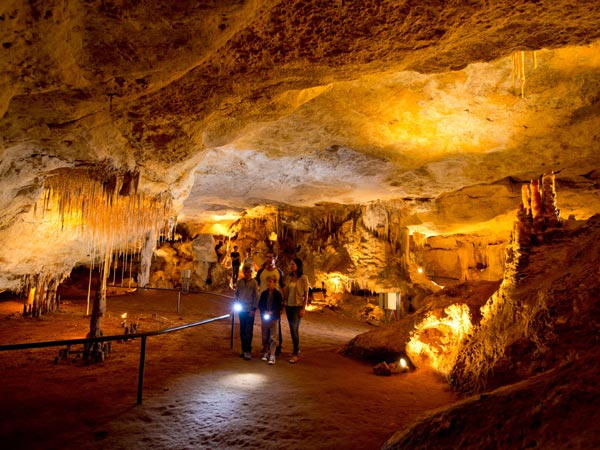
Wander through the warren of passages, festooned with stalactites and stalagmites inside Naracoorte Caves National Park. (Image: South Australia Tourism Commission/Adam Bruzzone)
Unlike many other caves in the region – or, in fact, many other caves in Australia – Tantanoola Caves Conservation Park is wheelchair-accessible. Just a 20-minute drive northwest of Mount Gambier, these vast, beautiful caverns are decorated with speleothems. Before your stroll freely through the subterranean wonder, each visit starts with an introduction from a guide, who will tell you the history and geology of the caves and explain how their formations have developed over thousands of years.
The largest regional gallery in South Australia, the Riddoch plays host to a large collection of early 20th-century Aboriginal art, interactive displays, free guided tours, and a daily screening of the documentary film Volcano, which chronicles Mount Gambier’s geological history and the Aboriginal Dreamtime story of the giant ancestor Craitbul.
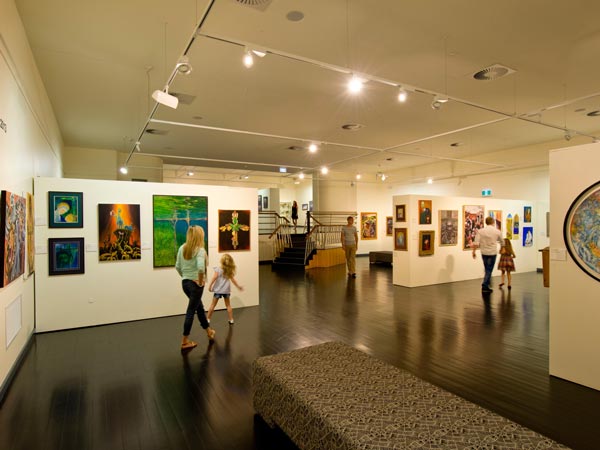
The Riddoch is the largest regional gallery in South Australia. (Image: South Australia Tourism Commission/Adam Bruzzone)
Every Saturday from 9am to 12pm, the Mount Gambier Farmer’s Markets are an easy, cheap and cheerful family-friendly experience. Grab a tasty takeaway breakfast from one of the stalls, shop fresh produce, and enjoy the stunning Cave Gardens where the markets are located.

Find all kinds of edible treats at the markets. (Image: Luna Socials & Design)
Foodies will be in heaven, with a wide array of seasonal fruit and vegetables, locally grown fish, pork, beef, honey, eggs and olive oil, and baked goods, and green thumbs will also find a whole lot of plants and seedlings on offer. A visit to the markets will make for a wholesome morning out.

Stock up on fresh produce. (Image: Luna Socials & Design)
Reconnect with nature and get the ultimate serotonin boost by hanging out and interacting with the animals at Mount Gambier’s Echo Farm. The charming farm has an assortment of historic displays as well as an opportunity to feed the animals, explore the outbuildings, and chat with the farmers who live on-site, making it a perfect activity for singles, couples, and families alike.

Feed the animals at the charming Echo Farm.
You can take a self-guided tour on Sundays to Fridays, and stroll around at your own pace taking in all the sights – the farm itself suggests allowing at least an hour for your visit. There’s also a range of snacks and souvenirs along with some delightful homemade scones. You can also book a guided tour most mornings.
Did you know Mount Gambier is an up-and-coming wine region? The wineries may be young, but they’re producing prized wines, with the region best known for its pinot noir. Due to the climate and rich volcanic soils, Mount Gambier is home to a handful of must-see emerging wineries from family-run businesses to boutique vineyards. From the well-known Herbert Vineyard, renowned for its silky smooth pinot noir, to the hidden gem that is Noski Wines, located on the slopes of the Blue Lake, you won’t be short of places to visit for a tipple.
Kilsby sinkhole’s crystal clear water makes it one of the best diving and snorkelling locations in Australia. Book a 50-minute guided tour to learn the history and geology of this naturally occurring karst sinkhole and/or enjoy the tranquillity of the water by booking a snorkel tour.

Dive into the clear waters. (Image: Adam Stern)
To enjoy beautiful views of the volcanic, lake-dotted countryside, head 190 metres above sea level to the Centenary Tower. The medieval-looking tower opened in 1904 and was built to commemorate 100 years since Mt Gambier was first sighted by Europeans.
Original article written by Chloe Cann with updates by Tahlia Pritchard and Rachael Thompson.
This was very helpful I’ll be visiting the area in November and will be sure to check out some of these places